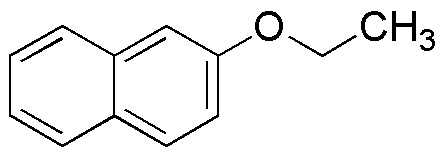2-Ethoxynaphthalene is widely utilized in research focused on:
- Organic Synthesis: This compound serves as a key intermediate in the synthesis of various organic compounds, making it valuable for chemists developing new materials or pharmaceuticals.
- Fluorescent Dyes: It is used in the production of fluorescent dyes, which are essential in biological imaging and analytical chemistry, helping researchers visualize cellular processes.
- Polymer Additives: In the plastics industry, it acts as a plasticizer and stabilizer, enhancing the flexibility and durability of polymers, which is crucial for manufacturing high-performance materials.
- Research in Photochemistry: The compound is utilized in photochemical studies, aiding in the understanding of light-induced chemical reactions, which is important for developing solar energy technologies.
- Flavor and Fragrance Industry: It finds applications in the formulation of fragrances and flavorings, contributing to the production of appealing scents and tastes in consumer products.
General Information
Properties
Safety and Regulations
Applications
2-Ethoxynaphthalene is widely utilized in research focused on:
- Organic Synthesis: This compound serves as a key intermediate in the synthesis of various organic compounds, making it valuable for chemists developing new materials or pharmaceuticals.
- Fluorescent Dyes: It is used in the production of fluorescent dyes, which are essential in biological imaging and analytical chemistry, helping researchers visualize cellular processes.
- Polymer Additives: In the plastics industry, it acts as a plasticizer and stabilizer, enhancing the flexibility and durability of polymers, which is crucial for manufacturing high-performance materials.
- Research in Photochemistry: The compound is utilized in photochemical studies, aiding in the understanding of light-induced chemical reactions, which is important for developing solar energy technologies.
- Flavor and Fragrance Industry: It finds applications in the formulation of fragrances and flavorings, contributing to the production of appealing scents and tastes in consumer products.
Documents
Safety Data Sheets (SDS)
The SDS provides comprehensive safety information on handling, storage, and disposal of the product.
Product Specification (PS)
The PS provides a comprehensive breakdown of the product’s properties, including chemical composition, physical state, purity, and storage requirements. It also details acceptable quality ranges and the product's intended applications.
Certificates of Analysis (COA)
Search for Certificates of Analysis (COA) by entering the products Lot Number. Lot and Batch Numbers can be found on a product’s label following the words ‘Lot’ or ‘Batch’.
*Catalog Number
*Lot Number
Certificates Of Origin (COO)
This COO confirms the country where the product was manufactured, and also details the materials and components used in it and whether it is derived from natural, synthetic, or other specific sources. This certificate may be required for customs, trade, and regulatory compliance.
*Catalog Number
*Lot Number
Safety Data Sheets (SDS)
The SDS provides comprehensive safety information on handling, storage, and disposal of the product.
DownloadProduct Specification (PS)
The PS provides a comprehensive breakdown of the product’s properties, including chemical composition, physical state, purity, and storage requirements. It also details acceptable quality ranges and the product's intended applications.
DownloadCertificates of Analysis (COA)
Search for Certificates of Analysis (COA) by entering the products Lot Number. Lot and Batch Numbers can be found on a product’s label following the words ‘Lot’ or ‘Batch’.
*Catalog Number
*Lot Number
Certificates Of Origin (COO)
This COO confirms the country where the product was manufactured, and also details the materials and components used in it and whether it is derived from natural, synthetic, or other specific sources. This certificate may be required for customs, trade, and regulatory compliance.

